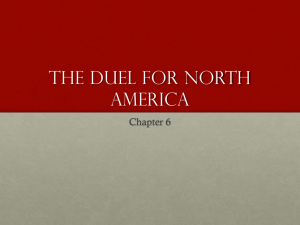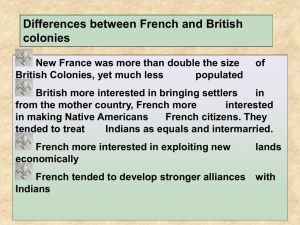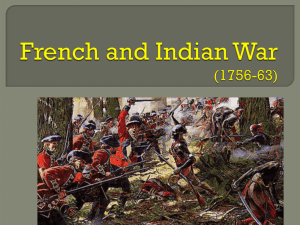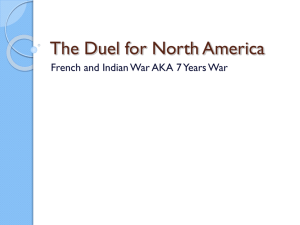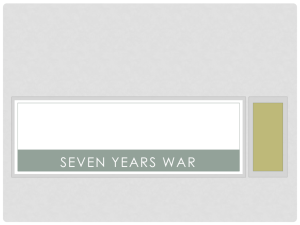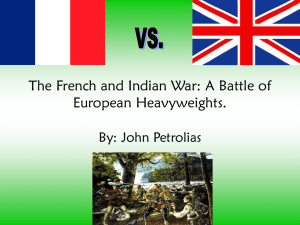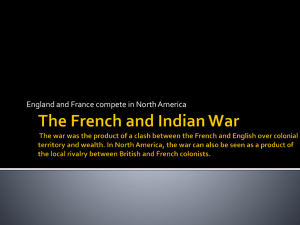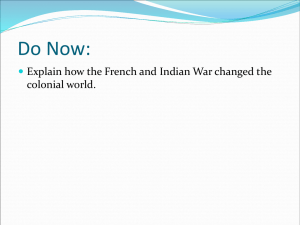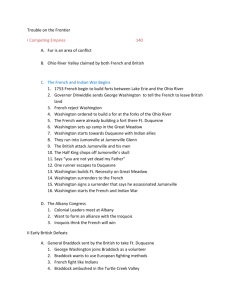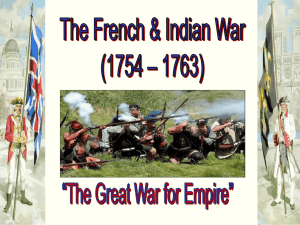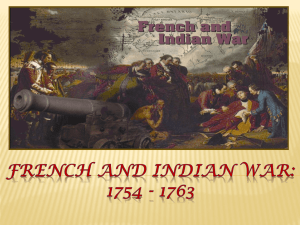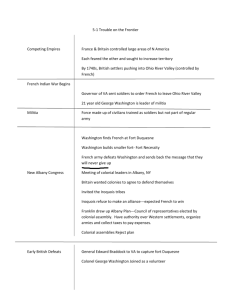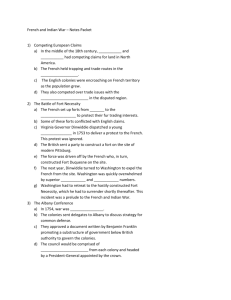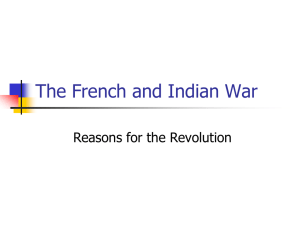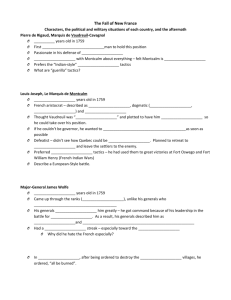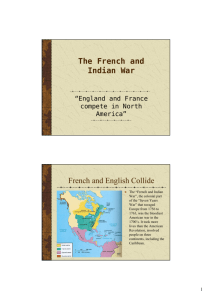Differences between French and British colonies
advertisement
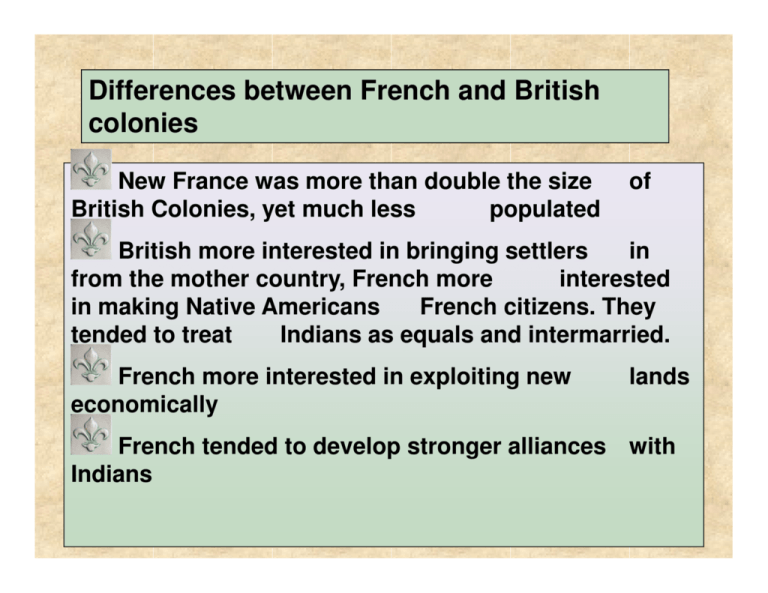
Differences between French and British colonies New France was more than double the size British Colonies, yet much less populated of British more interested in bringing settlers in from the mother country, French more interested in making Native Americans French citizens. They tended to treat Indians as equals and intermarried. French more interested in exploiting new economically lands French tended to develop stronger alliances with Indians 1 The French and Indian War 1754-1763 Disputed land claims in Western Pennsylvania in 1754 brought two of the greatest world powers to a conflict that spread in both the New World and in Europe. 2 3 Duquesne was claimed by the French and the British Duquesne (modern day Pittsburgh) was located at the convergence of three major rivers, the Ohio, the Allegheny, and the Monongahela. Long seen by both the French and British as the key to the rich farmlands and settlement opportunities in the Ohio River Valley, both France and England laid claim to the area. When the British found that the fort had been built, a young officer by the name of George Washington was dispatched to warn the French to get out of the area. 4 Fort Necessity George Washington, a 22 year old militia officer, was sent by the British to deliver the ultimatum to the French. Washington constructed an outpost approximately 60 miles from Duquesne called “Fort Necessity” 5 Attack at Jumonville Glen The first skirmish between the French and Washington’s men took place not far from the fort. Washington and Indian allies attacked a French position at a location known as Jumonville Glen. Within a few minutes, 10 Frenchmen were killed and 21 wounded. "I fortunately escaped without any wound, for the right wing, where I stood, was exposed to and received all the enemy's fire, and it was the part where the man was killed, and the rest wounded. I heard the bullets whistle, and, believe me there is something charming in the sound." A few days later the French retaliated against Washington’s position, and Washington surrendered Fort Necessity. Washington became embroiled in controversy because the surrender document written by an interpreter incorrectly deemed the French diplomats instead of combatants, making Washington a murderer. --George Washington 6 British attack on Fort Duquesne The next year in 1755, British General Edward Braddock was ordered to attack the French stronghold at Fort Duquesne. Assigned as his aide was George Washington. Braddock and his 1500 men were confident they could take the fort, but they were ambushed outside the gates by French soldiers and their Native American allies. During the battle, Braddock and his staff were killed with the exception of Washington. The British defeat at Fort Duquesne was only the first of many losses suffered during the period of 1755-1756. 7 Prime Minister William Pitt The French were initially victorious over the British military. However this changed dramatically when King George III picked new leaders to run the British government. William Pitt, as prime minister, put together a massive army of 50,000 men to fight the French, but had to borrow a large amount of money to do so. 8 Battle of Quebec Wolfe (British) The commanders Montcalm (French) 9 The Battle of Quebec The battle was fought outside the city of Quebec on the “Plains of Abraham” Wolfe had 4800 men under his command, Montcalm, 4000 Wolfe’s men scaled cliffs protecting the city and surprised Montcalm. Montcalm could have evacuated the city, but elected instead to fight Wolfe’s men British losses in the battle were 58 killed, 600 wounded French losses were 644 men killed or wounded Both Wolfe and Montcalm were killed in the battle Battle ended in a decisive British victory 10 The British victory caused the French to surrender Benjamin West painted this portrait of the death of Wolfe 11 Treaty of Paris 1763 Ended the French and Indian War France ceded Canada and all land claims east of the Mississippi River to England France kept the island colony of Guadeloupe Spain received Louisiana and New Orleans from the French, Cuba was restored to Spain Spain temporarily ceded Florida to the British 12 Impact of the war France lost most of its overseas empire The size of British holdings in North America doubled with the acquisition of Canada and territory to the Mississippi River The British treasury went deep into debt to pay expenses for the war. Eventually they tried to pay for much of the expense of the war by taxing the Thirteen Colonies, which led, in part, to the American Revolution The French sought ways to maintain the “balance of power” in Europe by undermining Britain’s power whenever possible. This led them later to support the colonists in the American Revolution While the British saw their empire grow substantially, they also found that it became increasingly difficult to manage such a large territorial area Britain became the dominant world power at that time 13 Pontiac’s Rebellion 1763-1766 Various Indian tribes, concerned with the number of British soldiers entering the Ohio River valley region, united behind Ottawa Chief Pontiac in an attempt to reclaim lands for Native Americans. Indians were successful in capturing eight British forts, but were weakened when British officers gave them smallpoxinfected blankets during peace negotiations. They eventually entered into treaties with the British, and gave up control of the lands they’d taken. 14 Proclamation of 1763 Faced with a difficult task of guarding an expansive empire in the New World, King George III issued the Proclamation of 1763, which kept settlement to the east of a line drawn at the Appalachian Mountains. The Proclamation also sought to stop the exploitative sale of Indian land. Another purpose of the Proclamation was to forestall further frontier warfare after Pontiac’s Rebellion. 15
